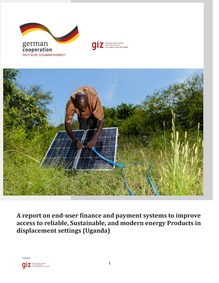Click here to register!
End-User Finance and Payment Systems in Displacement Settings in Uganda
Regional Overview
Uganda is one of the largest refugee hosting countries worldwide currently hosting more than 1.5 million refugees [1]. The lack of quality energy products and services for cooking and lighting, communication (phone charging), and productive use limits opportunities to meet basic needs, ensure protection, and strive for self-reliance. Limited income generating opportunities restrict ability to acquire energy solutions. On the other hand, limited access to affordable energy options is a barrier to employment creation, business opportunities, innovation, and market development and thus to economic development. Despite the efforts of various humanitarian and development partners, significant barriers to the access to modern energy products and services remain.
The underlying country study was conducted in Rhino Camp and Imvepi settlement in Uganda. Rhino Camp has a population of 125,000 with almost all being South Sudanese, while Imvepi has a population of 70,000 showing a similar rate of origin. In Rhino Camp, females make up 50% and youths make up 27% while in Imvepi settlement, females make up 52% and youths 23%. The main economic activity in both settlements is farming followed by manpower services and tailoring in Rhino Camp and housekeeping, labourers and small business owners in Imvepi settlement.
Productive Use of Energy Needs
A number of livelihood programs have been implemented in the refugee and host community settlements of Rhino Camp and Imvepi. Although a few programs are implementing PUE solutions, it’s on one stage of the value chain i.e., either planting (solar irrigation) or processing (milling machines). Interviews with refugee and host community beneficiaries give reasons for the need for PUE solutions along the different phases of the different value chains that they are involved in. However, due to the high cost of PUE solutions and low incomes of farmers, they are unable to afford the solutions.
The study established that savings-groups are prevalent in both refugee and host communities. Banks and microfinance institutions (MFIs) have no presence except for RUFI which has an office in Ofua III Rhino Camp as well as Vision Fund and BRAC that utilize credit officers. Due to the limited capital and short repayment periods of savings groups, members rely on them to finance short term inexpensive needs. A few groups have accounts in Banks like Post Bank, Housing Finance Bank, DFCU and MFIs like RUFI and Vision Fund. Through these linkages they can borrow bigger amounts which they can repay in 10 months to a year.
Existing and Planned End User Finance (EUF) and Payment Systems
The pre-dominant EUF options are PAYGo, Village Savings and Lending Associations (VSLAs) and Financial Service Providers (FSPs). A number of factors enable and hinder their usage:
- PAYGo via mobile money: Enabling factors such as phone ownership, lack of collateral makes it an ideal EUF option. However, factors such as unreliable connectivity and low literacy hinder its uptake.
- VSLAs: being locally owned and managed by the members as well as easy access makes them the most ideal savings and borrowing mechanism for refugees and hosts. However, they have short repayment periods (1 month until 3 months) and disburse low amounts that aren’t sufficient to acquire PUE solutions.
- FSPs: access to subsidized loans from Uganda Energy Credit Capitalization Company (UECCC), awareness programs on solar solutions, convenient offsetting models enable their usage. Conversely, limited reach, unclear KYC policy, lack of physical collateral hinders their uptake.
Policies and Framework Conditions
The Bank of Uganda (BOU) has the mandate to supervise and regulate the operations of financial institutions in the country. A number of acts and regulations govern this mandate and the supervision of financial institutions. However, they are designed for the local population with no mention being made of refugees as can be seen from “Know Your Customer (KYC)” requirements for account opening collateral and financial card requirements for credit access. As a result, acts and regulations impact the supply of and demand for financial services. The policies don’t regulate interest rates charged by FSPs leaving them to go high when the Bank of Uganda lowers its Central Bank Rate (CBR), Bank agents who ideally bridge the distance between banks and rural populace offer limited services of which loan processing is not a part of.
EUF Concept
EUF options were ranked based on their abilities to address financial challenges and needs of end users. The factors considered were interest rates, loan duration, loan size, account opening and credit requirements, access, turnaround time, proximity, initial deposit requirements. Based on the factors, VSLAs, FSPs and PAYGo ranked highly. Separately however, they are unable to address EUF need. Bundled together in pairs, they are able to leverage on each other strengths and address their weaknesses. The EUF concepts below are most appropriate.
- Linking VSLAs to FSPs for acquisition of costlier PUE solutions
- VSLA formally registers at the sub-county, opens an account in the bank and starts depositing group savings in order to qualify for bigger loans
- VSLA and PAYGo for acquisition on less costly PUE solutions and SHSs
- Borrow from VSLA to cover the initial deposit that is usually 15%-20% of the equipment cost and covers the remaining balance using PAYGo
References
- ↑ Office of the Prime Minister (2021): Population Summary by Settlement/Sex. Uganda Refugees & Asylum seekers as of 31/October/2021. https://data2.unhcr.org/en/documents/details/89513
The report can be downloaded here:
Partners
GIZ's Energy Solutions for Displacement Settings (ESDS) project cooperate with UNHCR to enhance the access to sustainable energy in displacement contexts, and the Energypedia page has been created to share learnings across various practitioners to spur the development of clean energy solutions.





















